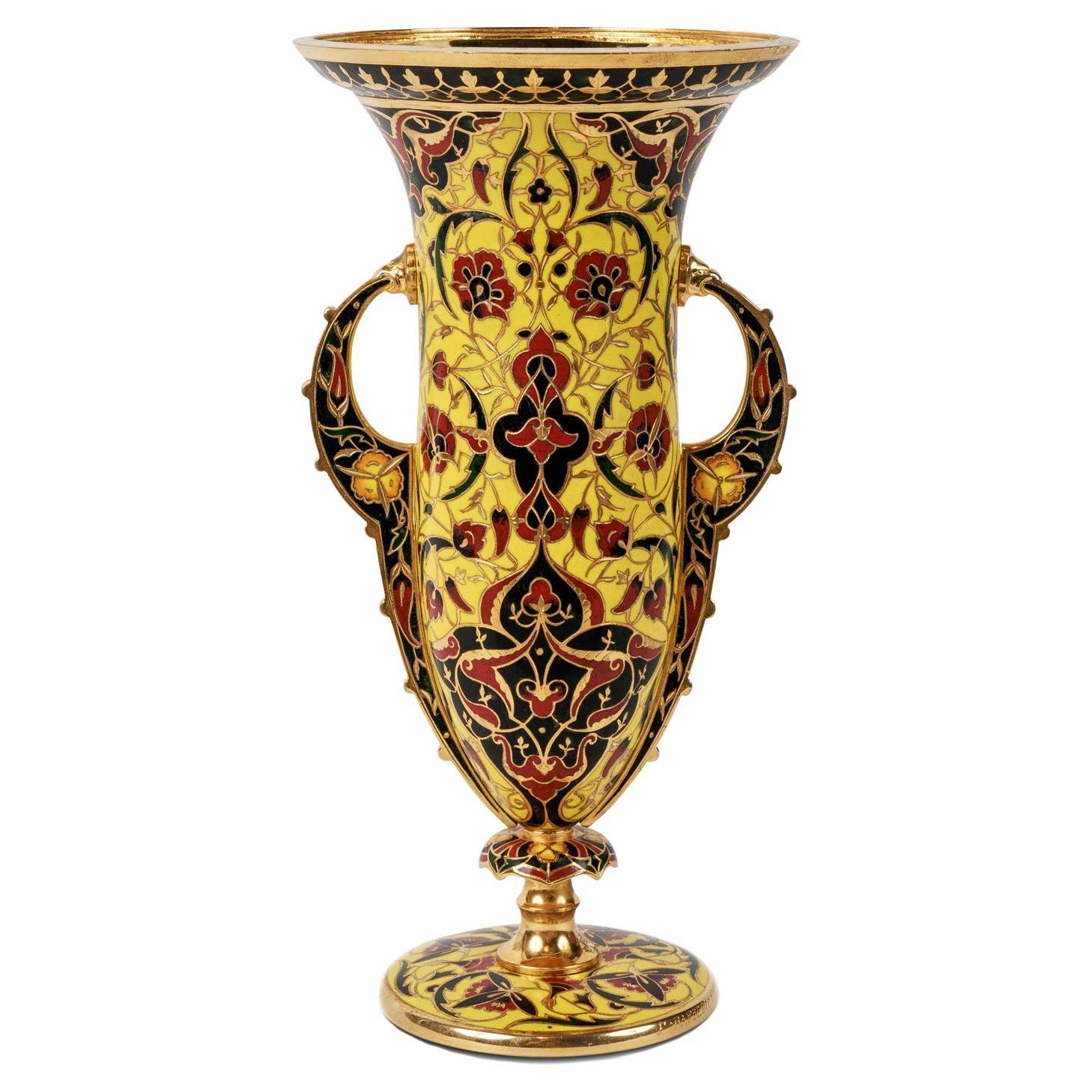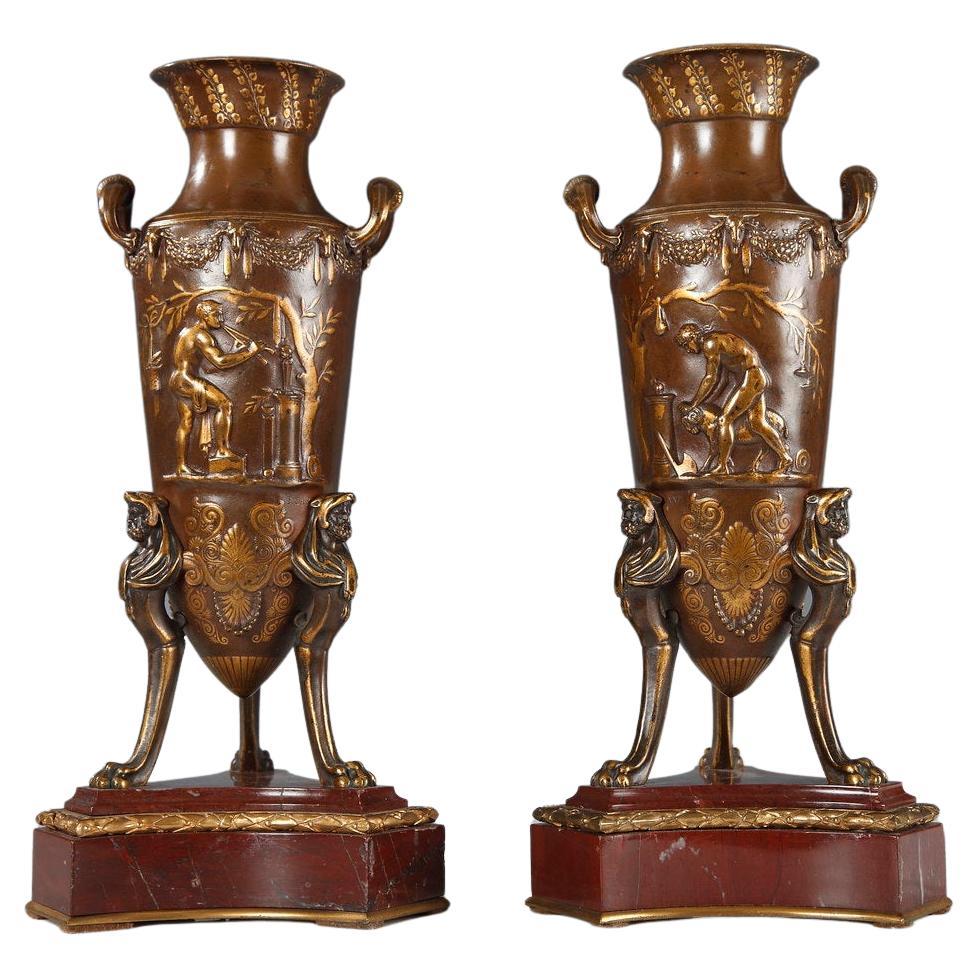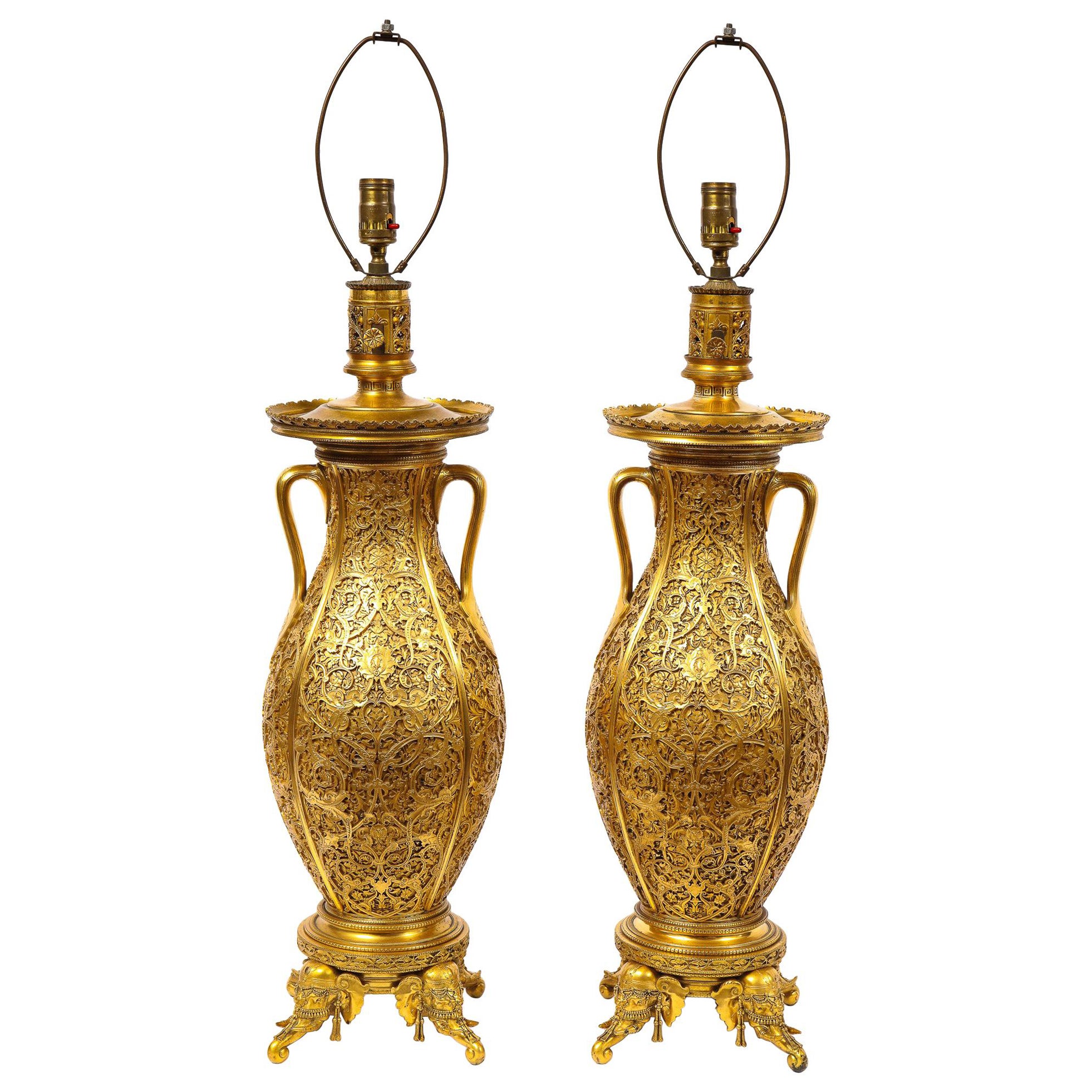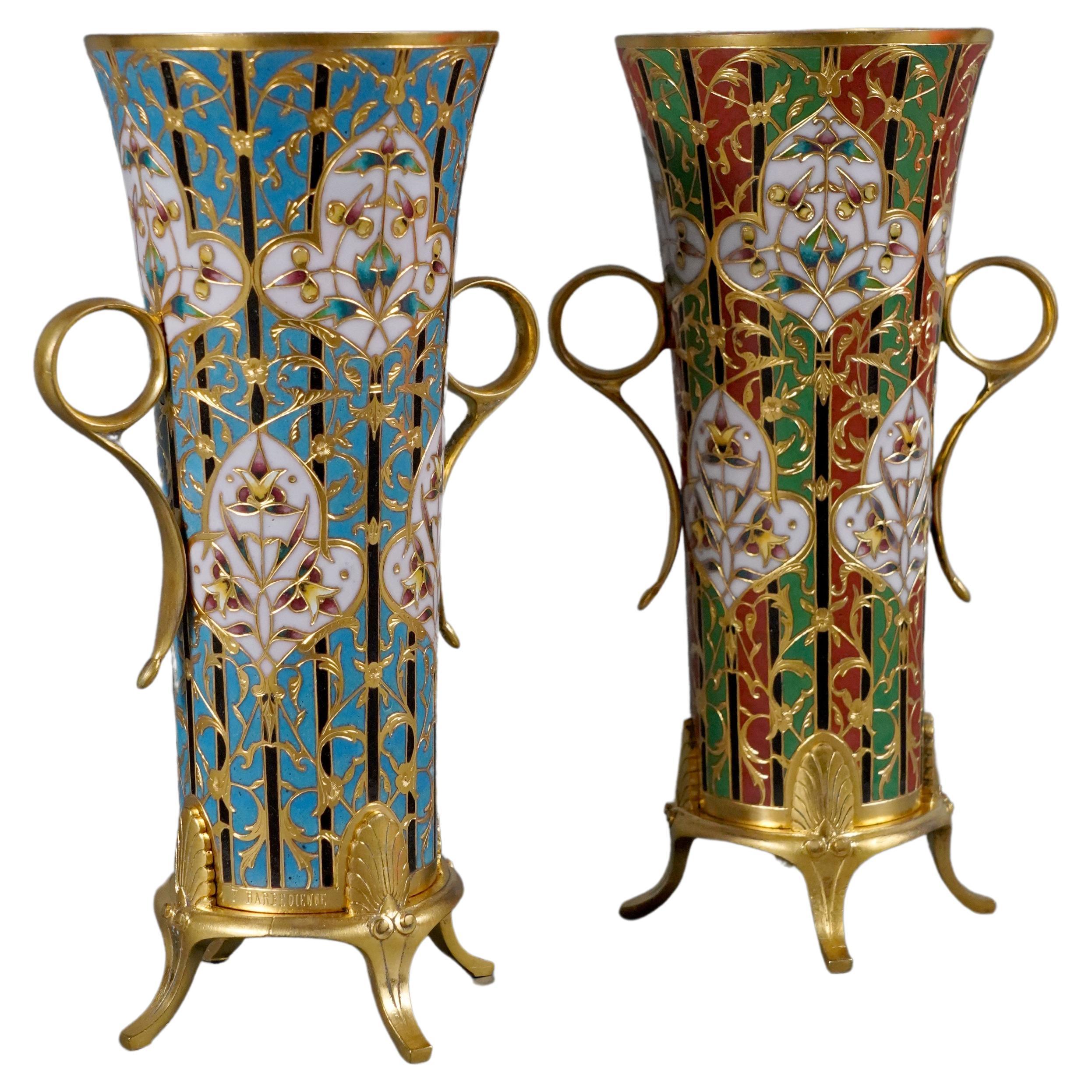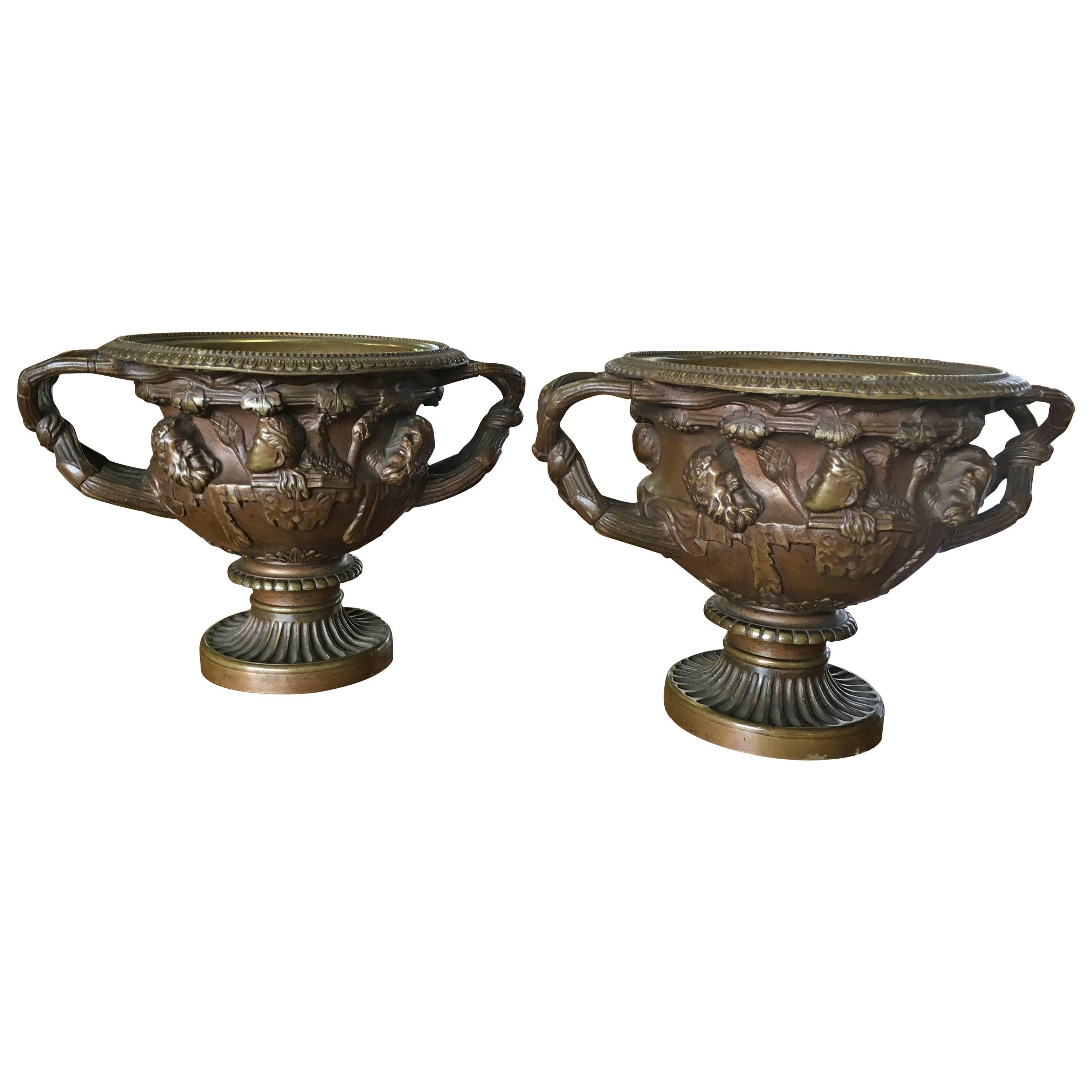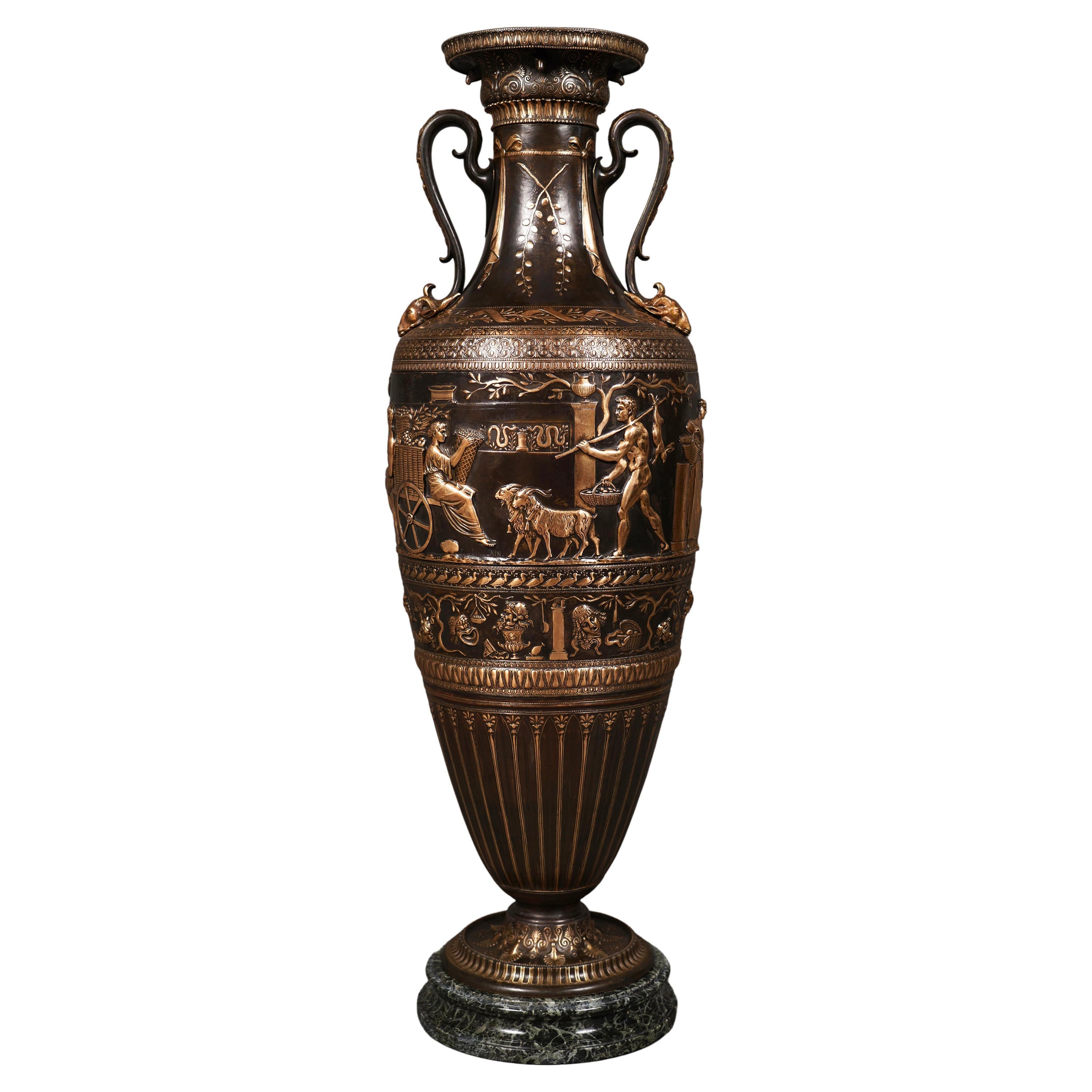Items Similar to Pair of Small Cloisonné Enamel Vases by F. Barbedienne, France, Circa 1880
Want more images or videos?
Request additional images or videos from the seller
1 of 9
Pair of Small Cloisonné Enamel Vases by F. Barbedienne, France, Circa 1880
About the Item
Signed F. Barbedienne on the mount.
Charming pair of small curved-shaped vases in patinated and gilded bronze and polychrome cloisonné enamel decorated with flowers and birds. With two movables handles, they rest on four winding feet.
Born in 1810, Ferdinand Barbedienne started one of the most famous 19th century artistic bronze casting companies. He died in 1892. In addition to his personal production, he worked for famous artists such as Clésinger, Carrière-Belleuse and Guillemin. Barbedienne’s production was always highly esteemed and he was, himself admired by contemporary art critics who compared him during the 1878 Universal Exhibition to a « prince of industry and the king of bronze-casting ». In the catalogue of the Exhibition, Barbedienne was considered as the leader among 19th century bronze casters, because of the exquisite quality of his bronzes.
- Creator:Ferdinand Barbedienne (Maker)
- Dimensions:Height: 6.7 in (17 cm)Diameter: 3.94 in (10 cm)
- Sold As:Set of 2
- Style:Japonisme (In the Style Of)
- Materials and Techniques:
- Place of Origin:
- Period:
- Date of Manufacture:circa 1880
- Condition:Wear consistent with age and use. Minor fading.
- Seller Location:PARIS, FR
- Reference Number:
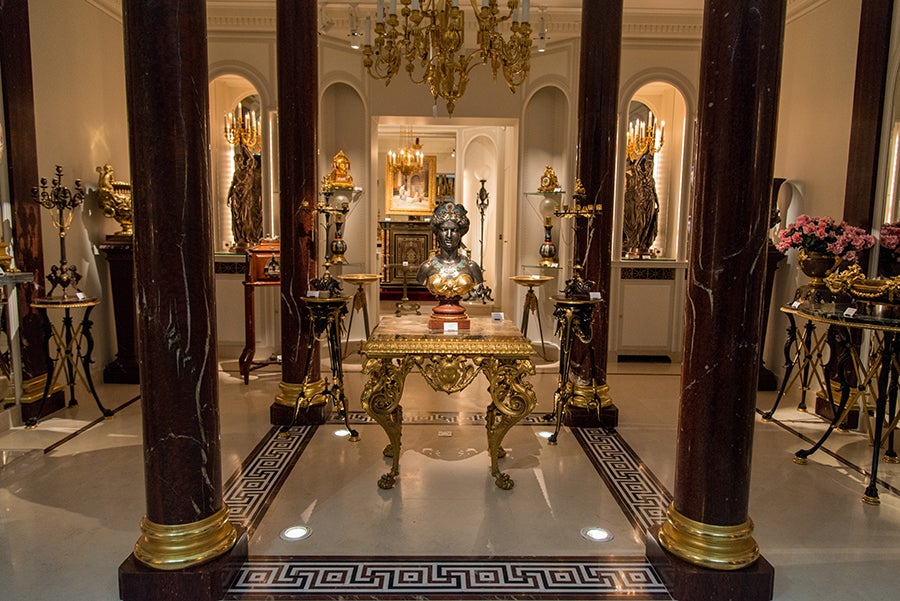
About the Seller
4.9
Vetted Seller
These experienced sellers undergo a comprehensive evaluation by our team of in-house experts.
Established in 1997
1stDibs seller since 2018
76 sales on 1stDibs
Typical response time: <1 hour
Associations
International Confederation of Art and Antique Dealers' Associations
- ShippingRetrieving quote...Ships From: PARIS, France
- Return PolicyA return for this item may be initiated within 7 days of delivery.
More From This SellerView All
- Pair of Neo-Greek Amphora Vases by Barbedienne and Levillain, France, circa 1880By Ferdinand Barbedienne, Ferdinand LevillainLocated in PARIS, FRPair of Greek style vases made two patina bronze. Each, designed in the shape of a tripod amphora adorned with Hercules heads, is decorated in low-relief...Category
Antique 1880s French Greek Revival Vases
MaterialsGriotte Marble, Bronze
- Pair of Trumpet-Shaped Byzantines Vases, L.C. Sevin&F. Barbedienne, France, 1880By Ferdinand Barbedienne, Louis-Constant SevinLocated in PARIS, FRSigned F. Barbedienne A pair of charming trumpet-shaped vases in gilt bronze with a polychrome cloisonné enamel decoration, one blue and the other green and red. They feature two annular handles and stand on four feet surmounted by a stylized palm. The vases are ornated with a Byzantine decoration. The high quality of the enamel is typical of Barbedienne’s production. It enhances this pair of vases especially with the wide range of colours used to create the decoration. The enamel is smooth and shiny and shows many shades to form the Byzantine decoration. The partitioned cloisonné is finely engraved and contributes to the decoration by adopting vegetal and foliage shapes. The Model These two vases can be linked to a vase presented by Ferdinand Barbedienne at the 1862 London Universal Exhibition and purchased at this time by the South Kensington Museum (now the Victoria and Albert Museum, London, Inv. 8026-1862). This vase has on its belly a polychrome cloisonné enamel decoration standing out against a turquoise background as show these vases. This decoration, called Byzantine, covers all the vase with coloured arabesques and scrolls. It rests on four claw feet with lion heads from a design near of our vases. Barbedienne and the Cloisonné Enamel Ferdinand Barbedienne continously innovated and he revived the use of enamel on art works during the second half of the 19th century. The Sèvres Manufacture enamel workshop had ever tried it in 1854-1855, but Barbedienne was the one who succeeded to join enamel to an industrial decorative objects production. From 1858 “At Mr Barbedienne’s, enamels in copper ornaments have got their former prestige back” (Les bronzes de la Maison Barbedienne, C. Simon, in L’Art du XIXe siècle, 1858, n°21, p. 252). The Barbedienne Company had now an enamel workshop where objects ornamented with oriental style or medieval style enamels were made. Four years after, Barbedienne’s cloisonné...Category
Antique 1880s French Other Vases
MaterialsBronze, Enamel
- Large Neo-Greek Vase by F. Levillain & F. Barbedienne, France, circa 1890By Ferdinand Levillain, Ferdinand BarbedienneLocated in PARIS, FRImportant neo-Greek vase in the shape of an Amphora, made in two patina bronze. The body is decorated with a rich continuous frieze in bas-relief presenting a procession of characters carrying their offerings to the temple, underlined by a decoration of theatrical masks among olive trees. The 's'-scroll handles decorated with grape vines, resting only on the shoulder of the vase, are supported by a ram’s head. Numerous palmettes and friezes adorn the whole. Resting on a molded marble circular base. Biography Ferdinand Levillain (Paris, 1837-1905) studied under the sculptor Jouffroy (1806-1882), before making his debut in 1861 at the French Artists Salon where he continued to exhibit until 1903. At the 1867 Universal Exhibition in Paris, he was praised for a Neo-Greek style bronze cup he made for the firm Blot and Drouard. He was not to become really famous, however, until 1871 thanks to his association with the great bronze founder Ferdinand Barbedienne, who began to exhibit Neo-Greek style lamps...Category
Antique 1890s French Greek Revival Vases
MaterialsMarble, Bronze
- Fine Pair of Neo-Greek Vases by F. Levillain and F. Barbedienne, France, c. 1890By Ferdinand Barbedienne, Ferdinand LevillainLocated in PARIS, FRSigned F. Levillain sculpteur and F. Barbedienne. Pair of Greek style vases made of two patina bronze. Each, designed in the shape of a amphora resting on four hoof feet and a quadrilobed base, is decorated in low-relief with ancient times scenes of grape harvest and picking hops. Overleaf vases, profiles of gods Ariadne and Bacchus are ornated with grape vines and cornucopias. The handles are supported by two bearded heads of gods. Here is the model titled Amphore vendangeurs, modèle n°1 (68 cm), edited by Barbedienne after 1891. We find it in the catalogs until 1911. The figure of Bacchus is a subject dear to Ferdinand Levillain, which he exhibited bronze medallions in his first exposition as well as Universal Exhibitions in which he participated. Ferdinand Levillain (Paris, 1837-1905) studied under the sculptor Jouffroy (1806-1882), before making his debut in 1861 at the French Artists Salon where he continued to exhibit until 1903. At the 1867 Universal Exhibition in Paris, he was praised for a Neo-Greek style bronze cup he made for the firm Blot and Drouard. He was not to become really famous, however, until 1871 thanks to his association with the great bronze founder Ferdinand Barbedienne, who began to exhibit Neo-Greek style lamps...Category
Antique 1890s French Greek Revival Vases
MaterialsBronze
- Important Pair of Neo-Greek Vases by Levillain and Barbedienne, France, C. 1878By Ferdinand Levillain, Ferdinand BarbedienneLocated in PARIS, FRThe model of these Etruscan Amphoras has been exposed at the 1878 Paris Universal Exhibition. Each with a waisted neck raised with bearded satyr ma...Category
Antique 1870s French Greek Revival Vases
MaterialsMarble, Bronze
- Charming enamel and gilded Bronze Ewer by F. Barbedienne, France, circa 1870By Ferdinand BarbedienneLocated in PARIS, FRSigned F. Barbedienne & Cie Height : 31,5 cm (12,4 in.) ; Width : 12 cm (4,7 in.) ; Depth : 10,5 cm (4,1 in.) Charming baluster-shaped ewer in gilded bronze decorated with red and blue polychrome cloisonné enamel. Two beaded handles connect the body to the slender neck, ending in a flared pouring spout, and it rests on a circular piedouche. The whole is decorated with abundant engraved decoration of foliage interlacing. Barbedienne and the Cloisonné enamel : Ferdinand Barbedienne continuously innovated and he revived the use of enamel on art works during the second half of the 19th century. The Sèvres Manufacture enamel workshop had ever tried it in 1854-1855, but Barbedienne was the one who succeeded to join enamel to an industrial decorative objects production. From 1858 “At Mr Barbedienne’s, enamels in copper ornaments have got their former prestige back” (Les bronzes de la Maison Barbedienne, C. Simon, in L’Art du XIXe siècle, 1858, n°21, p. 252). The Barbedienne Company had now an enamel workshop where objects ornamented with oriental style or medieval style enamels were made. Four years after, Barbedienne’s cloisonné...Category
Antique 1880s French Napoleon III Vases
MaterialsBronze, Enamel
You May Also Like
- Pair of French Japonisme Ormolu Vases E. Lièvre, Executed by F. BarbedienneBy Ferdinand Barbedienne, Edouard LievreLocated in New York, NYAn important and monumental pair of very fine 19th century French Japonisme/Orientalist ormolu vases designed by Edouard Lièvre and Executed by Ferdinand Barbedienne. Each body with an oval shape, finely sculpted in a floral design, fringed by orientalist style handles with cartouches, the neck surmounted by a circular pierced scrolling dragon frieze. Each vase resting on a group of four orientalist style jeweled elephant...Category
Antique 1870s French Japonisme Vases
MaterialsBronze
- 19th Century Pair of French Bronze Vases by F. BarbedienneBy Ferdinand BarbedienneLocated in Sofia, BGA wonderful pair of bronze vases with high relief by Bardedienne. France, circa 1870.Category
Antique Late 19th Century French Vases
MaterialsBronze
- Ferdinand Barbedienne, A French Ormolu and Champleve Enamel Vase, C. 1870By Ferdinand BarbedienneLocated in New York, NYFerdinand Barbedienne, A French Ormolu and Champleve Enamel Vase, C. 1870 In the Islamic / Alhambra taste. The two handled vase in Alhambra form, enameled in rich yellow throughout ...Category
Antique 19th Century French Napoleon III Vases
MaterialsBronze, Enamel, Ormolu
- Extremely Rare Pair of Ferdinand Barbedienne Ormolu and Champlevé Enamel VasesBy Ferdinand Barbedienne, Louis-Constant SevinLocated in New York, NYAn extremely rare, museum quality pair of Ferdinand Barbedienne ormolu and champlevé enamel vases, circa 1870, certainly designed by Louis Constant Sevin...Category
Antique 19th Century French Napoleon III Vases
MaterialsEnamel, Ormolu
- A Champlevé Enamel Jardinière by Ferdinand BarbedienneBy Ferdinand Barbedienne, Louis-Constant SevinLocated in Brighton, West SussexA Champlevé Enamel and Gilt-Bronze Mounted Jardinière by Ferdinand Barbedienne, the design attributed to Louis-Constant Sévin. This fine jardinière is decorated all over with foliate...Category
Antique 19th Century French Planters, Cachepots and Jardinières
MaterialsBronze, Enamel
- 19th C. French Islamic Champleve Enamel Vase and Underplate, Signed BarbedienneBy Ferdinand BarbedienneLocated in New York, NYA Fantastic 19th century French Islamic/Orientalist Style Champleve Enamel Vase and Underplate, Signed F. Barbedienne. The wide-mouthed vase terminates down a narrowing body and is m...Category
Antique 1850s French Islamic Vases
MaterialsBronze, Enamel
Recently Viewed
View AllMore Ways To Browse
Furniture Of French Leaders
Small Vases In Pairs
Small Gold Vase
Vase With Birds French
Enamel Flowers In Vase
Two French Art Vase
Small Bronze Flower
Small Bronze Vase
Antique Enamel Company
Enameled Bronze Vase
Bronze Vase Enamel
Cloisonne Enamel Vase
Polychrome Enameled Vases
Pair Gold Vase With Handles
Bronze Signed For Vase
Antique Cloisonne Vase Vases
Four Handle Vase
Small Enamel Vase
